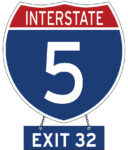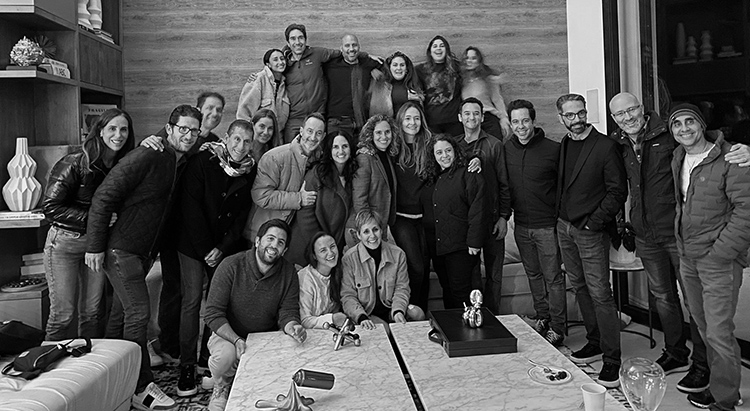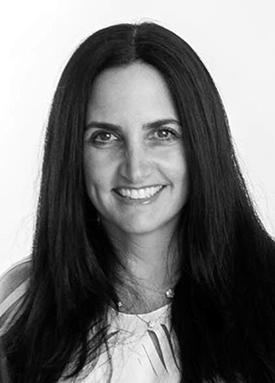 Editor’s Note: This is the 26th chapter in Volume 2 of Editor Emeritus Donald H. Harrison’s 2022 trilogy, “Schlepping and Schmoozing Along the Interstate 5.” All three books as well as others written by Harrison may be purchased from Amazon.com.
Editor’s Note: This is the 26th chapter in Volume 2 of Editor Emeritus Donald H. Harrison’s 2022 trilogy, “Schlepping and Schmoozing Along the Interstate 5.” All three books as well as others written by Harrison may be purchased from Amazon.com.
Schlepping and Schmoozing Along Interstate 5, Exit 32 (I-5 Bypass): Ken Jewish Community

 On Saturdays, the campus of the San Diego Jewish Academy figuratively is transformed into a nest – in Hebrew, a ken – where some 300 children with mostly Mexican roots are taught in Spanish about their culture, their traditions, and how to be good people, “who will serve the community and practice tikkun olam (repair of the world).”
On Saturdays, the campus of the San Diego Jewish Academy figuratively is transformed into a nest – in Hebrew, a ken – where some 300 children with mostly Mexican roots are taught in Spanish about their culture, their traditions, and how to be good people, “who will serve the community and practice tikkun olam (repair of the world).”

So comments Yanine Simpser, one of three members of the Board of Directors’ Executive Committee. She is in charge of overseeing some of the programming for the Ken Jewish Community – programming that helps to shape the children of community from infancy to high school graduation and beyond.
“At the Ken, we make lifelong friends who share our values and beliefs,” Simpser said. “We offer a variety of programs and activities that strengthen our human values and Jewish identity. We strive to build a connection to Israel and maintain our culture in a fun and experiential way.”
As infants, children of the Ken Jewish community participate with their parents in activities in activities exposing them to Jewish music, some Jewish traditions, and the fun of such Jewish holidays as Purim, Sukkot, and Chanukah.
In pre-school, each age level has a morah (teacher) who will broaden the children’s knowledge about Jewish traditions, holidays, and music. Once they reach the first grade, they will be led and taught by youth counselors (madrichim in Hebrew) who will help them participate in various interactive activities. The youth counselors, who are Ken teenagers, will design and create interactive activities (peulot) for them.
“Our madrichim are one of our biggest jewels,” Simpser commented. “They get to represent the acquired learnings absorbed during their trajectory at Ken and transmit them to the younger generations. Madrichim go through a year of intensive training before they assume their roles and responsibilities. During that year, they learn about leadership and the importance of being a positive role model in the community. They reinforce the Maccabi Worldwide Organization’s values of Jewish peoplehood, community involvement, Zionism, and love for Israel.”
“When they graduate from Aluma, our school for madrichim in training, they travel to Israel for several weeks and get immersed in Israeli culture,’ Simpser added. “The motivation behind this year of training is that they live and breathe their learning, that they explore and make mistakes, so when they assume their roles as leaders, they are able to transmit their beliefs from experience.”
She added that “some of these madrichim graduate from high school and take a gap year in Israel where they learn about Israel geo-politics, history, and technological advances. Also, they participate in the Marva, the Israeli Army’s three-month training program for foreign volunteers. They get to live in a kibbitz and do community service in Tel Aviv. Our hope is that once they become college graduates and come back to San Diego, they will assume leadership roles in our Jewish community.”
The young children’s activities are carefully scripted. “There is a time when they practice sports, a time when they eat and socialize, and a time when they participate in meaningful activities with their groups, called kvotzot,” said Simpser. “Such activities are meant to not only foster their love for Israel and Jewish traditions but also nurture their social and emotional wellbeing. It is not through papers and lectures that we teach. At the Ken, educators, volunteer parents, and madrichim come together to create a community and to transmit values through fun and experiential encounters.”
“It is a place where we all develop a great sense of belonging,” Simpser continued. “Our Maccabi Tikvat Majar (youth movement) strengthens our chanichim’s (youth groups’) identity and invites them to deeply connect with peers. In order to enrich their learning and emotional growth, the Ken offers a wide variety of programs. An example is our SABER program, which at an early age teaches our children to make better decisions.”
First graders learn about self-esteem and self-confidence and “it moves on by theme as they progress in age,” Simpser said. As they go on, the students will learn about “how to make good decisions, where and how to take risks. They learn about peer pressure and belonging, technology, and a series of topics such as how to respond t cyber-bullying or how to conquer fear.”
Year by year, there are themes to build their characters, “but we also bring additional resources to help them cope with whatever they are experiencing.” Suppose, for example, she said, “a kvutza (group) is expressing curiosity about how to maintain a healthy body or lifestyle,” a speaker would be brought in to address such issues.
“In high school, the program gives them a few sessions on individual, family, and community values and teaches them a few basic skills of negotiations, how to achieve what they want to achieve,” Simpser said. “It is nothing like school. What we do is hands-on with a very informal educational format. We always get to teach and entertain through activities in which they get to explore and experience things firsthand.”
In addition to the regular Saturday programming, Wednesdays are a special day for girls aged 11 and 12, Simper said. “Through our Bat Mitzvah program, they learn about Judaism and the women’s duties for Judaism. They talk to rabbis and rebbitzins about Shabbat, candle lighting and the mikvah (ceremonial bath). We take them there so that they have an idea of what being a Jewish woman means. Also, with this program we create spiritually meaningful moments between the girls and their families and the girls with their peers.”
Another group called Lehatjil (Start Learning) practices Israeli dancing in preparation for a competition featuring many Mexico City teams. “We have many interactions with the Mexico City community,” Simpser commented. “It is a very well-organized community and most of us are immigrants from there. We try to maintain close contact with the Jewish people in Mexico.”
On occasion, the Ken folk dancers will perform in Balboa Park on the Sunday, usually in May, when the House of Israel puts on a cultural show.
I expressed surprise that the Ken programs its activities on Saturdays, Shabbats, rather than on Sundays.
“We are a non-religious, non-Orthodox organization,” Simpser responded. “Our members are more available on Saturdays than any other day of the week. This is the way that the community has been for many years. Our population is Jewish, mostly Latin, and more specifically, the majority of our members have Mexican heritage. Therefore, we have implicit subtle traditions that we follow. Sunday for Mexican/ Latin families is a day that we just spend with the family and have meals together.”
Simpser said that “the bonds that the kids develop at the Ken are very strong. Most of their social life revolves around the Ken. If we do the activities on Saturday, when the Ken ends, the kids organize get-togethers, and they continue to socialize through Saturday evenings. Sundays, our family days, usually end with school assignments and homework.”
Among the programs offered by the Ken, Shorashim (Roots), in affiliation with Israel’s Museum of the Jewish People (Beit Hatfutsot) is an opportunity for children to learn about their family histories.
“They learn about their great-great grandparents, where they were born … what food they ate, what sports, what values, what did they do for their bar mitzvah,” Simpser said. Such questions are traced through the generations helping the children to understand “how did they get to where they are now.”
“The children make pictures, share their stories, and learn about the many places their family members lived – or in the case of the Holocaust, where they were forced to live – on the multigenerational journeys that eventually brought them to Mexico and later to San Diego.”
“Then we have them go to Mexico City and learn where the first synagogue was built,” Simpser said. “They look at pictures; they have access to the archives that the community has there. They can search for their last names and learn what the meaning of their last name is and get pictures of their parents, or grandparents playing soccer at the sports center (Centro Deportivo Israelita) in Mexico City.”
Once a year, there is a contest organized by the Museum of the Jewish People (formerly known as the Museum of the Diaspora) for the most deeply researched family history and for the most beautiful art piece depicting that history, with winners brought to Israel to compete with other Jewish youngsters from all over the world.
“I was fortunate enough to go there with my older boys,” Simper confided. “We flew there. We were able to interact with kids their age from Spain, Turkey, Costa Rica, all over the world. They all told stories about their families and their grandparents, and they learned that even though their story was special and unique, it was in many ways similar to the stories of different families all over the world. In sum, these stories tell the overall story of the Jewish people.”
The Jewish community at the Ken has members who are from Ashkenazic and Sephardic families who have left behind some of the cultural differences among Jewish ethnic groups in Mexico City.
“Mexico City’s Jewish community is about 50,000 people,” Simpser noted. “It is extremely vibrant and well organized. It is also divided in sub-communities. There are the Ashkenazi (Jew coming from Central and Eastern Europe) and the Sephardi (tracing their heritage to 15th century Spain and Portugal). The Sephardic community is also divided into three communities, depending on where the grandparents came from: the Maguen David and the Monte Sinai (Jews coming originally from different places in Syria) and Communidad Sefaradi (Jews coming from Spain and Turkey.) Each sub-community has its own synagogues, schools, and cemeteries. Although it is now fortunately better, Mexican Jews would hardly intermarry with Jews from a different sub-community.”
“That was how I grew up,” Simpser reflected. “We were Jewish so far as the outer (non-Jewish) community was concerned, but within our community there were cultural differences. Mexico City has not been the safest place in the last years. People have moved from there to other places, like myself. I ended up in San Diego. When I got here, I found that those Jews who I thought were ‘so different,’ were extraordinarily similar to me. We all came here to make one community.
“I am Ashkenazi, but I cook Arabic food because I like it more,” she continued. “My close Sephardic friends have taught me. They share their holiday recipes. We go to the same synagogues. It is really interesting how that works. Also, food in not a minor topic. We eat Jewish Mexican food. It is an interesting and eccentric combination because we add chili (spice) and salsa to everything. We eat the Ashkenazi gefilte fish with a spicy tomato sauce from Veracruz, Mexico, called ‘Gefilte a la Veracruzana’ On the Sephardic side, we eat kibe with tahini, hummus, guacamole, salsa, and, of course, we eat takis (rolled corn tortilla chips) and jicama with Tajin chili.”
So, I asked, do the Mexican Jews mix with Jews from other countries?”
“Of course we do!” she responded. “First of all, the Ken is open for any Jewish families who’d like to learn Spanish, become acquainted with our Latin roots, and celebrate Judaism with us. In fact, a portion of our members are a mix of South Africans, Israelis, Colombians, Argentines, and Americans. Secondly, we as individuals have dear friends who are non-Ken members. The Ken is just one aspect of our lives. In that specific context, we try to reinforce the Spanish language to our kids because many were born in the U.S. or came here at a young age. We share interests that are part of our heritage as Jewish Mexican immigrants such as music, food, and some implicit cultural Latin/Mexican values, like the value of family.”
“Now, of course, through work, school, extracurricular activities, our members have other spaces and opportunities to interact with other non-Mexican Jewish and non-Jewish people,” Simpser added. “My kids go to the San Diego Jewish Academy, and they have great South African, Israeli, and American friends who are also Jewish. They do hang out. They do mix with other Jewish people in their school and with non-Jewish people outside of school in their extracurricular activities such as soccer and dance. As individuals, we satisfy our needs through many different channels and sources. The Ken for us is our home away from home and we are just one big family.”
I asked Simpser whether the Ken was involved with any cross-border activities with the Jewish communities of Mexico.
She answered that the Ken had its start in Tijuana when it was founded by Ana “Janche” Galicot, who today continues to run the Ken-affiliated local chapter of the Women’s International Zuonist Organization (WIZO). “She would bring the kids to her home to teach them about bar and bat mitzvah, and then the community started to grow; they moved to San Diego, and it grew and grew. The community there [in Tijuana] is almost gone. We do help the few Jewish families who are living in Tijuana. We also have helped the non-Jewish community with our Tikkun Olam ‘Hands-on Giving’ program. All our children participate in activities around feeding the homeless, caring for the elderly, honoring veterans, and so forth, both in San Diego and Tijuana.”
“One year we went to build a house for orphans,” Simpser said. “We built it there with our own hands. We put the bricks, and the kids helped. We painted the place. We then donated food, blankets, and beds for the children there. It’s a small place for about 20-30 children.
“With another project, our children sell avocados once a year to raise money. With that money they help Tijuana children who are blind. The amazing Dr. (Arturo) Chayet does surgery on cataracts for kids who are blind. They recover their sight. When we have a child who had come through the surgery, he or she visits the Ken (which had raised money to pay for the surgery) and our chanichim get to meet and talk to this person. We are all the time looking for projects that are meaningful. We hope every kid at the Ken learns to be a responsible, caring human being by doing tikkun olam. We very much hope they learn to be lifelong givers.”
Unfortunately, projects in Tijuana have been curtailed because “the cross-border lines are too long,” Simpser said. “So, more recently, we do help the community but from a distance. We put together packages and send them to different orphanages – goody bags, school supplies.”
Often at San Diego County community-wide events, such as the Yom Ha’atzma’ut (Israel Independence Day) celebration at the Lawrence Family JCC (in non-COVID years), children of the Ken can be seen wearing Maccabi Youth Movement uniforms, which resemble those of the Scouts but represent an international organization which, like the Ken, is dedicated to teaching manners and values to youth and contributing to the community.
After high school graduation, “we still attend to our graduates through a program called Chai Plus. We do a Thanksgiving party for college students where they meet again and find love,” Simpser said. “We have had some successful marriages that come out of those reunions. We are working to implement a program where we bring the students back to San Diego and find sponsors who are willing to hire them in jobs and be mentors to them as to where and how to start a new business.”
There are also cultural activities for adults. “Our Israel Project brings experienced speakers in current topics related to Israel,” Simpser said. “We offer a wonderful community celebration of Yom Ha’atzma’ut and a community ceremony for Yom Hashoah (Commemoration of the Holocaust.) We also offer cooking classes and social opportunities for mingling. We love to see our community constantly interacting in vibrant and lively settings.
“Also,” she continued, “we have a strong and active group of volunteers called Ohr Ami (Light of Friends) that gives support to Jewish families going through vulnerable stages in their lives. For example, mothers who give birth get a basket from us. Families going through mourning get meals from the community. People who get sick get the same thing. People who need money for their businesses, or whatever, if they have a real need, the community will help. The community will pay for their rent, for their surgery, for things that are really necessary for a family.”
Among American Jews, it is very common for children at age 18 or so to go to college and leave the nest. But for Mexican Jews, it is quite different. The hope is that the children will quickly return to the ken and m’dor l’ dor, generation to generation, continue to teach and uphold Mexican customs and Jewish values that the community holds dear.
*
Donald H. Harrison is editor emeritus of San Diego Jewish World. He may be contacted via donald.harrison@sdjewishworld.com